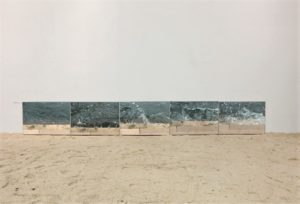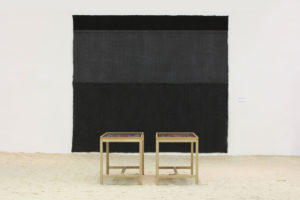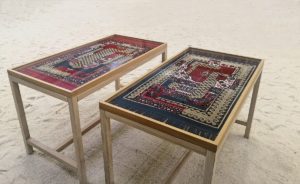At the end of the 1980s, in the world, there was a growing realization of the idea of globalization which beginning was symbolically marked by the fall of the Berlin Wall in 1989. However, in Serbian region, the situation was quite the opposite: while factual and imaginary walls were tumbling down in Europe, in our former Yugoslav state they were about to be raised rapidly, so instead of globalization, we faced a sudden localization. The ranges of movement, both physical and mental, constrain almost to the complete isolation of society, the ghettoization of culture and the marginalization of art.
In response to the war and the crisis of all previous (moral, cultural, human) values, some postmodern artists begin actions based on the idea of protest and critique of reality while others “distance themselves”, i.e. continue with their work, so their artworks from this period do not reflect the obvious justification in the context of the unfortunate times and the restricted space in which they emerged. In my opinion, such actions, as a form of deflection from reality, were part of the revolt, but not through clearly defined activities that reflected the attitude of being “against”, but through passive creation of personal microcosm in an attempt to preserve the integrity and autonomy of art for some better times. It is significant to note that both forms of protest retain the tendency toward high art criteria as its dominant characteristic.
The change of political power in 2000 brought a new uplift to the art scene but it also introduced neo-liberal capitalism that treats art as an industry and artwork primarily as a commodity which value is exclusively determined by the market; therefore, art is also expected to find its new place within the so-called “creative industries”.
Today, in Serbian well-known polarized society, there are still two courses: one derived from the 1980s heritage (openness, European and world orientation), and the second based on the heritage of the 1990s (traditionalism, nationalism, kitsch as a mainstream). Too established to be an alternative, too numerous to be a subculture, the postmodern artists in today’s simulacrum of normality remain faithful to themselves and position themselves in relation to the new, engaged art.
Now, some examples from the exhibition “80s & 90s Today – The Rhythm Divine”, Galerija SLU, Niš.
Perica Donkov’s Deaf Room of monumental format is an extremely emotional, statement artwork. In the deaf room there are no sounds: the person and the process of sustaining his/her life are the only sounds – heartbeats, breathing, “sound” of thoughts absorbed by the walls of the room. The deaf room represents the area of absolute isolation of an individual. The visual rhythm depicts slowness, immutability, and the conceptual rhythm depicts reflections, contemplations and, most of all, emotions. The work is characterized by a minimalist, conceptual approach to art and complete abstraction – a reduced, pessimistic colouring (grey, black), horizontal lines and surfaces – suggest a fence or a border.
Dark, almost monochrome photos with rare light and colour accents make Nina Todorović’s installation Defensive Structures Underground. While retaining their documentary character, the photographs foremost expresses the emotional aspect of intimate confrontation with the fear of “the others”. The dark atmosphere of alienation is present in underground spaces articulated by architectural elements (supporting concrete pillars and wire fences like cages) that the artist accurately, analytically frames. The wired fence motif is present in almost every photograph: even when there is an empty space in the centre of the composition, they are somewhere around, loom from the sides, or we feel that they are hidden in the dark. These are not just “our” cages, but also the cages of “others”, placed next to each other. The work radiates the silence – there is no communication, every man is an island here.
Marija Dragojlović’s frieze Water presents five authorial photos on which the artist intervened in colour, imprinting a personal note, a part of her memories and emotions into her photo work. The representation of the sea which ripples hitting the white stones of the Venetian canal awakens in us the sense of intimacy, the atmosphere of memory, the evocation of the personal experiences of the sea, the rhythm of overwhelming thoughts and emotions.
Srđan Apostolović’s work Dual Activ, created by combining and collating two prayer kilims, represents a combination of ready-made and conceptual logic. The rhythm of kilims’ design patterns, the rhythm of the artistic intervention of fragmentation, uncovering and coverage, the rhythm of colours create a playful, elegant conceptual puzzle of an unexpected customisation.
Vladimir and Milica Perić’s installation titled Salt of the Earth is a conceptual upgrade of their work Kleine Garten (Small Garden). Having collaged the same detail, one for every of thirty-seven different author photographs showing fences of an Austrian village and the vegetation behind and in front of them, 37 kaleidoscopic patterns – “small gardens” of an hexagonal form are created to be given a new life by Perić artistic tandem. The visual rhythm defines the radial expansion of the patterns with fences and greenery in the hexagon centres, and the conceptual continuation of growth and new life occurring in the jars with the earth beneath them. Artificial small gardens create an allusion of “plastic” life in the post-humanistic era, while the natural processes of the formation of moulds and bacteria in and on earth in the jars bring us back to the very beginnings of life on earth. Mini-installations (small gardens on a jar filled with soil) behave as separate units – each for themselves but together they make a unique body of different plants.
 Marija Dragojlović, Water 1-5, 2015, photos digitally printed on aquarelle paper, dry pastel, colour pencils, (5x) 79×120,5 cm, courtesy of the author and ART-ZOOM
Marija Dragojlović, Water 1-5, 2015, photos digitally printed on aquarelle paper, dry pastel, colour pencils, (5x) 79×120,5 cm, courtesy of the author and ART-ZOOM
 Nina Todorović, Defensive Structures Underground (001, 004, 009, 011, 012, 014, 015, 023 i 024,) 2009-13, Lambda print, (9x) 100×56 cm, courtesy of the author and ART-ZOOM
Nina Todorović, Defensive Structures Underground (001, 004, 009, 011, 012, 014, 015, 023 i 024,) 2009-13, Lambda print, (9x) 100×56 cm, courtesy of the author and ART-ZOOM
 Perica Donkov, Deaf Room – pressure, 2019, acryl on sackcloth, 350 x 320 cm, courtesy of the author and ART-ZOOM
Perica Donkov, Deaf Room – pressure, 2019, acryl on sackcloth, 350 x 320 cm, courtesy of the author and ART-ZOOM
 Srđan Apostolović, Dual Activ, 2016, wood, textile, (2x) 67x124x75 cm, courtesy of the author and ART-ZOOM
Srđan Apostolović, Dual Activ, 2016, wood, textile, (2x) 67x124x75 cm, courtesy of the author and ART-ZOOM
 Vladimir i Milica Perić, Salt of the Earth, 2017, installation, digital print on plastic, 37 jars containing soil; in total 37 elements (single element dimension: 25×29 cm), variable dimension. Courtesy of the authors and ART-ZOOM
Vladimir i Milica Perić, Salt of the Earth, 2017, installation, digital print on plastic, 37 jars containing soil; in total 37 elements (single element dimension: 25×29 cm), variable dimension. Courtesy of the authors and ART-ZOOM

Graduated Art history at the University of Belgrade, Faculty of Philosophy. Former curator and a member of in Lucida Gallery art council. One of the founders and director of the association for the development and promotion of contemporary visual arts ART-ZOOM. Lives in Belgrade, Serbia.






NO COMMENT